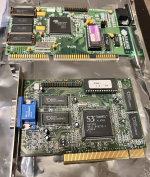The VESA is supposed to do all VESA modes up to 1280x1024x8 and 1024x768x16, so I think that'll be fine. As for the SB, I've read in some lawsuit papers from Creative about the marketing of the MediaGX that it's not 100% compatible, but it's like 2% of games that won't work, so I'm sure it'll do fine for my needs. The only worry I have is that the MPU-401 support for MIDI is disabled by default in Compaq units, purportedly, so I'll either have to look at enabling that, or hope my games don't use MIDI (I don't think they do, they all use FM Synth and Digitized sound afaik). However, it's also supposed to support hardware MIDI, so there should be a header for that and I have a daughterboard hooked up to one of my soundcards, maybe it's compatible - but if not, I can buy one.
I also read that the chipset has an ISA and PCI bus, meaning that if I get super-adventurous, I can figure out how to make an adapter for an expansion chassis and wire up a few PCI and/or ISA slots and solve any issues that I might have with compatibility. ;D
The idea is really not to screw with the system though, so I'd rather avoid that unless purely for fun.

